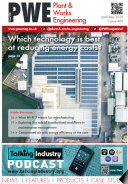Think smart
Published: 03 March, 2016
When referring to modern technology, companies bandy the word "smart" around a lot, especially when talking about energy efficient devices. We have smart meters, smart grids and even smart cities. In November 2015, for the first time in history, the National Grid resorted to paying large companies to turn off their heating, ventilation and air conditioning (HVAC) systems in an effort to keep the lights on in Britain. Nick Boughton, sales manager of systems integrator Boulting Technology, discusses a smarter approach to energy efficiency.
We are living and working in a post-industrial economy in which electricity consumption in commercial buildings is significantly higher than it was 25 years ago. Back then, offices comprised of the odd computer, lighting, a photocopier and perhaps a fax machine and that was about it. If it got too warm, you opened a window and if it got too cold, you put another jumper on.
In comparison, many modern offices are like mini data centres. HVAC, modern computers and servers are power-thirsty equipment that consumes energy especially at peak times of the day. When you think about all the technology parks around the country, made up of these types of offices, you could argue that the National Grid resorting to last ditch tactics is perhaps inevitable.
It is important to remember this is the first time the National Grid has had to implement this kind of emergency action. The reason given was that a number of old coal and nuclear power plants have been shut in recent years and while they have been replaced by new gas powered and renewable sources, the margin between capacity and demand is now much smaller. And if the margin becomes negative, someone’s lights will go out. The perfect storm is a cloudy day with no wind, when solar and wind sources generate less energy.
Two things are worrying about this situation. The first is that the money paid to companies to reduce energy consumption comes from levies on consumer energy bills. The users pay for this. The second is that according to some predictions, we will be relying less on coal and more on renewable energy, nuclear and natural gas in the future. In fact, earlier this year, the UK government pledged to phase out coal plants by 2025, which means the transition will happen sooner than expected. To make sure the UK is not caught unprepared, alternative power supplies need to be set up as soon as possible and more efficient energy management needs to be implemented in consumer and industrial environments.
This is where smart grids come in. Today’s smart grids use software to manage decentralised energy generation, transmission and distribution according to the demand. Despite the technology and systems being available, the National Grid felt it had to resort to paying companies to manually turn off their HVAC.
Gone should be the days of tactics like phoning power plants to up the generation because there is an advertisement break in Christmas Day's episode of Coronation Street and everyone has just turned the kettle on. Energy management needs to be smarter.
Instead of paying companies to manually turn off their HVAC systems, there is no reason why this cannot be done automatically. The infrastructure and technology is available and in some cases, already in place.
For roughly 15 years, high and medium voltage grid applications in the UK have been using smart technology. In this context, smart means the technology works from detailed analytics and adjusts supply to suit peaks or troughs in demand automatically. In recent years, we have also started to see intelligent technology introduced into low-voltage applications too.
Every building is equipped with low-voltage circuit breakers that control and protect the distribution of power for things like lighting, HVAC and IT systems. Traditionally, these have been straightforward on/off dumb switches based on tried and tested technology because they have to remain reliable over long periods. However, with the quest for greater energy efficiency and smarter control of low-voltage applications, more intelligent breakers are required in modern office environments.
Building operators have started using smart circuit breakers to have more control over day-to-day energy operations. Smart circuit breakers can act as a network analyser to monitor power quality and give warnings that allow for the protection of sensitive electrical equipment. More important on the energy efficiency front is that the latest circuit breakers manage the power flowing through them and keep it below set limits. They do this by automatically disconnecting non-priority loads, like HVAC, in the event of load peaks.
Energy efficiency and smart technologies go hand in hand and the wider the adoption of devices like smart circuit breakers, the greater the results for the environment. In addition, going without HVAC for an hour probably will not affect a company greatly. However, if power margins continue to stay low, we risk blackouts and manufacturing lines could suffer costly downtime. Definitely not smart.
For further information please visit www.boultingtechnology.co.uk






